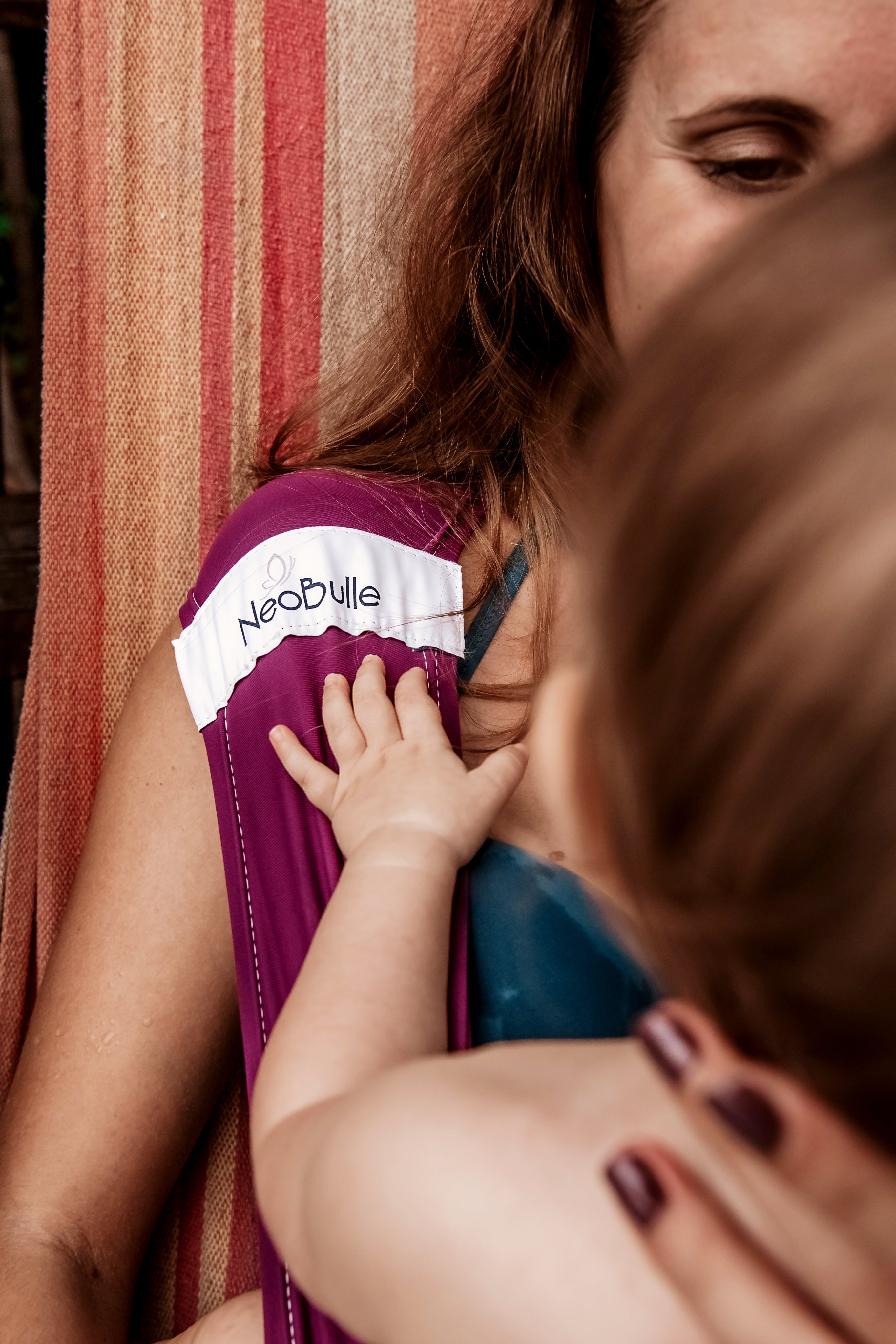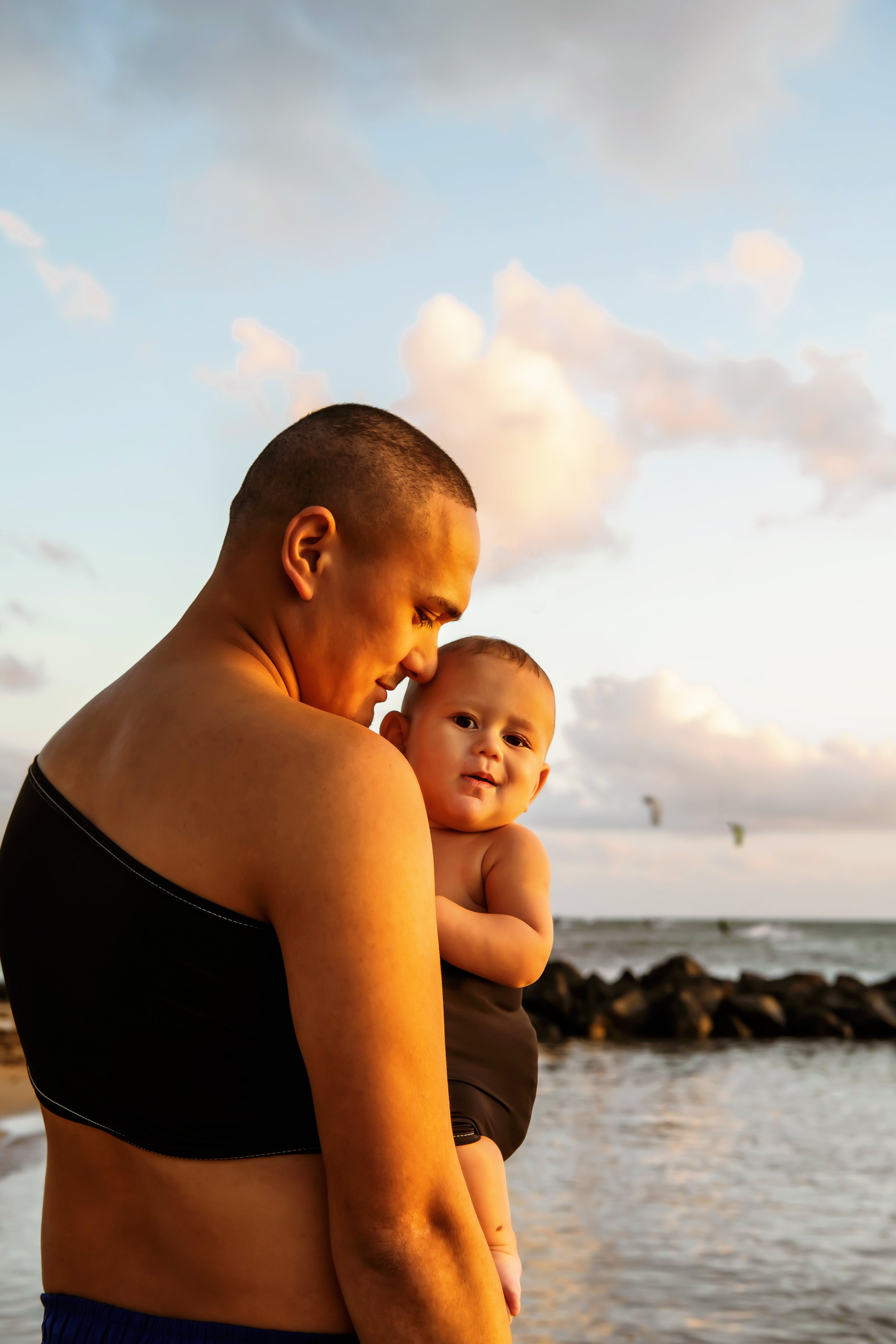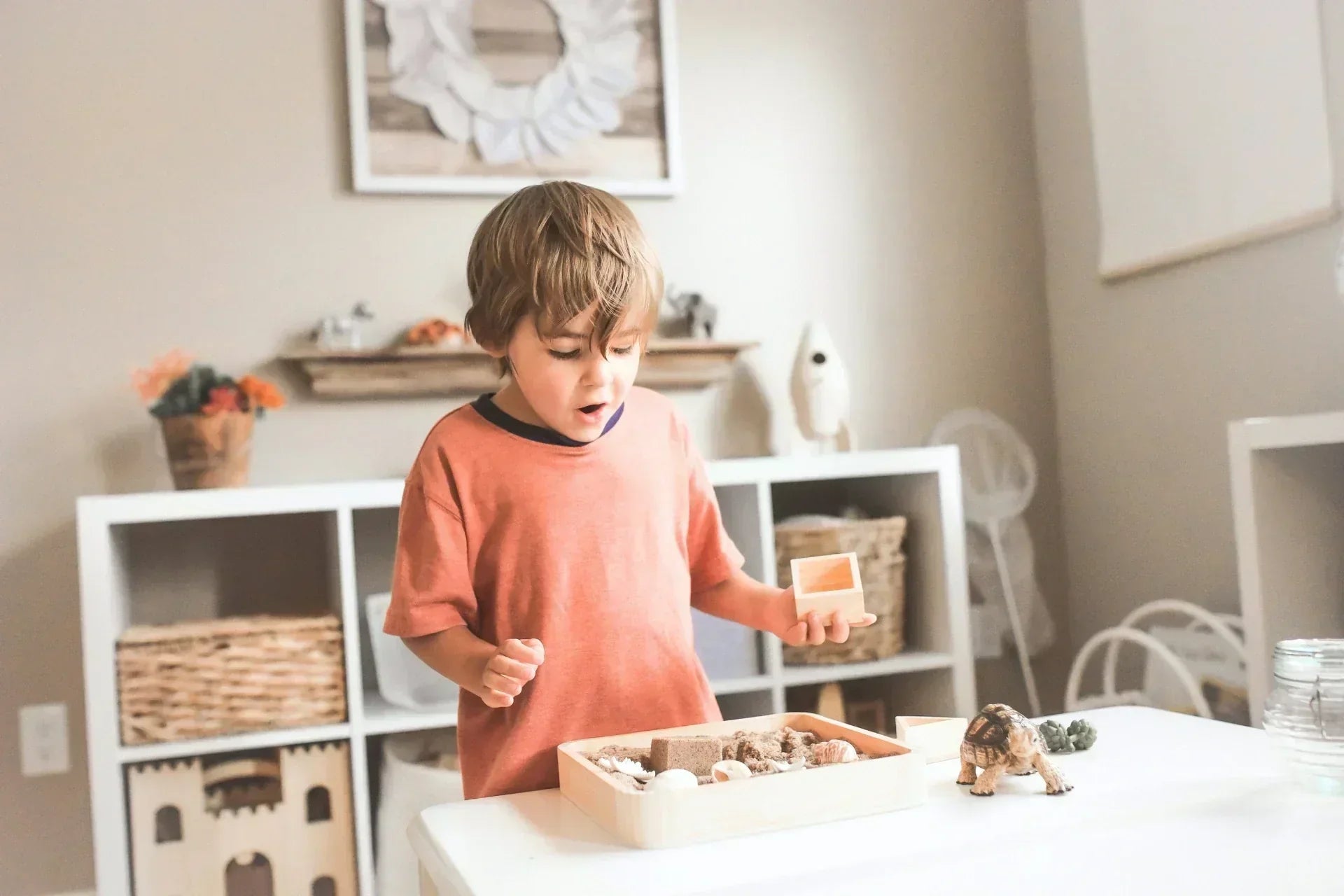Is it really possible to combine baby carriers and breastfeeding ? The answer is yes, a thousand times yes—and it's actually a valuable practice, both for the baby's well-being and the parent's comfort.
Far from being reserved exclusively for expert parents, breastfeeding in a baby carrier meets a real need for new mothers. Paternity leave flies by in the blink of an eye, and they soon find themselves alone with their newborn. This practice is gradually becoming more widespread , as knowledge about proximal parenting, skin-to-skin contact, and neuroscience research evolves. Today, more and more breastfeeding mothers are discovering the freedom that carrying offers: spontaneous feedings, easier travel, a stronger bond... Baby carrier and breastfeeding, a combo that transforms everyday life!
At Néobulle, we've been supporting new parents for over 15 years with products designed to simplify family life while respecting the physiological needs of babies. And if the idea of breastfeeding in a scarf or sling still seems vague to you, this article is here to shed light on everything. You'll find concrete advice, expert opinions on babywearing and breastfeeding, product recommendations, and above all, a strong message: you can breastfeed anywhere, with confidence, and at your own pace.
Summary- Carrying while breastfeeding: a natural tandem
- Babywearing and breastfeeding, an ancestral practice, brought up to date
- What is the best baby carrier for breastfeeding?
- How to carry a baby for breastfeeding, step by step?
- The pros' opinion on breastfeeding while carrying
- In conclusion: baby carriers and breastfeeding, a precious alliance
- Our recommendations for a peaceful breastfeeding experience
- In summary
Carrying while breastfeeding: a natural tandem
At first glance, breastfeeding while carrying a baby may seem technical or daunting. However, upon closer inspection, these two practices are based on the same fundamentals : proximity, observation, and rapid response to the baby's signals and therefore their needs. They are therefore intimately linked on a physiological and emotional level.
Babywearing stimulates the production of oxytocin, the bonding hormone, which plays a key role in enabling milk ejection. This closeness also promotes the secretion of prolactin, which is involved in the lactation process. The result? Increased milk production! Skin-to-skin contact, the warmth of the parent's body, and gentle movements create a secure environment for the baby, who can then nurse more peacefully, even in stimulating situations such as in the city, in a store, or during a family celebration.
Many breastfeeding mothers describe a newfound sense of freedom thanks to babywearing. No more searching for a quiet bench, no more shortened feedings due to a lack of comfort, or no more delayed outings for fear of a "hunger crisis"! With the right baby carrier, breastfeeding becomes seamless and discreet. And most importantly, it no longer forces you to choose between meeting your child's needs and continuing your daily activities.
Babywearing and breastfeeding: an ancestral practice brought up to date
In many traditional cultures, mothers carry and breastfeed their children while going about their daily lives. In Africa, Latin America, and Asia, this is a norm that has been passed down from generation to generation for centuries.
In the West, these practices, forgotten with the rise of industrialization and childcare, are reappearing thanks to the "proximal mothering" movement, which values proximity to the baby.
Today, thanks to the right baby carrier and a few simple tips, breastfeeding in a baby carrier is becoming accessible and intuitive. The secret? Choosing the right baby carrier, learning the right techniques, and allowing yourself to adjust according to your needs. You don't need to be an expert at tying knots or an experienced baby carrier. It's all about listening to yourself, trusting yourself, and following your own rhythm... and that of your baby.
What is the best baby carrier for breastfeeding?
There is no “perfect” model for combining babywearing and breastfeeding. It all depends on the comfort of the breastfeeding person, the size of the baby, and even the season.
Choosing the right baby carrier for breastfeeding is therefore very personal . What works for one friend may not work for you—and that's perfectly fine. That said, some baby carriers make breastfeeding easier every day because of their flexibility, ease of adjustment, and minimal adjustments.
● The baby sling: precise fit and maximum comfort
The woven baby wrap provides optimal fit, maximum comfort, and great versatility . It is therefore ideal for the first few weeks and long feedings at home. Guaranteed cocoon effect, the woven wrap molds to the shape of the mother and baby's body.
Learning may seem a little technical at first, but I promise, after two or three tries, you'll have mastered the movements!
 Good to know: Several positions are possible depending on your child's age. With a newborn, mothers prefer the Madonna position, which allows them to support the baby's head with their arm. If your baby is 4 or 5 months old, it is possible to breastfeed directly upright, without undoing your knot!
Good to know: Several positions are possible depending on your child's age. With a newborn, mothers prefer the Madonna position, which allows them to support the baby's head with their arm. If your baby is 4 or 5 months old, it is possible to breastfeed directly upright, without undoing your knot!● The sling: speed and discretion

For express or on-the-go feedings , the sling is a great ally. It is tied with two rings and allows you to carry your baby on your front or on your side. Simply loosen the fabric slightly to position your baby at breast height, then tighten it again. Lightweight, space-saving, and quick to install, it is often the favorite of urban or nomadic parents.
● Preformed baby carriers: physiological, comfortable and flexible
More and more parents are opting for preformed baby carriers for easy, mobile breastfeeding. Some models allow you to adjust the straps or straps to lower the baby slightly during feeding. However, not all preformed carriers are suitable for breastfeeding. Good news: at Néobulle, our baby carriers offer the flexibility needed for peaceful breastfeeding, while ensuring a physiological posture that respects both the baby... and the parent.

How to Carry a Baby for Breastfeeding, Step by Step
As with breastfeeding in general, there is no single right way. However, there are several guidelines that can help you get started safely:
- Start in a quiet environment , at home, to get used to the position and settings.
- Settle in comfortably, because combining baby carriers and breastfeeding is good, but being well-positioned is the foundation. A pillow under your arms, a backrest to support your back, a bottle of water within reach... and hey presto, we can move on to installing the baby at the breast!
- Loosen the fabric or straps slightly to position baby at breast height.
- Make sure his head is free and his airway is clear.
- Support the breast if necessary, especially at first, to guide your baby's mouth.
- Once the feeding is finished , bring the baby up to kissing height, tighten the baby carrier and check his position: belly to belly, rounded back, knees raised in an "M".
And above all, take your time. Every mother-baby duo is different. So it's perfectly normal for the first few times to be a little awkward. Being kind to yourself is essential.
💡 Would you like support in your discovery of babywearing? Contact a Babywearing Instructor who practices in your area! She will guide you step by step during an introductory workshop on physiological babywearing. We also offer online workshops to help you get to grips with your Néobulle babywearing method. Access the online calendar in one click!
The pros' opinion on breastfeeding while carrying
Many lactation consultants and babywearing instructors encourage this practice, as long as it is done safely. According to La Leche League , an international breastfeeding support organization, “babywearing allows breastfeeding on demand, which is essential for the successful establishment of lactation.” ( source )
To carry safely , the baby's airways must be clear. There is no need to cover the baby's head with fabric. Once this rule is respected, carrying allows the mother to feed her child without interrupting her activities, which is very rewarding, especially at the beginning.
Good to know: Some midwives also point out that babywearing can soothe babies suffering from colic or reflux. Indeed, the upright position after feeding is beneficial in these cases. Here again, babywearing becomes a concrete aid in breastfeeding.
In conclusion: baby carriers and breastfeeding, a precious alliance
Carrying your baby while breastfeeding is much more than a question of practicality: it is an extension of the bond , a way of listening to the needs of your child while respecting yourself. It is also a precious resource for experiencing breastfeeding with more freedom, respecting your rhythm and your body. Of course, it requires a little practice, sometimes trial and error, and above all a lot of kindness towards yourself.
So you don't need to be an "expert" in babywearing or have breastfed several children for this experience to be smooth and enjoyable. What matters is the gradual adjustment , feeling safe and having access to informed information. Each breastfeeding session can become a small moment of complicity, whether it takes place at home, on a walk, or in the heart of everyday life.
👉 Discover our selection of Néobulle products designed to support breastfeeding with complete peace of mind.
Our recommendations for a peaceful experience when combining baby carriers and breastfeeding
For those who want to get started, here are some simple and proven tips from the field:
- Start in a familiar, quiet setting so that learning can be stress-free.
- Your comfort is essential, practice sitting first, before considering moving to standing.
- If you feel the need, cover your chest with a small swaddle or scarf for a discreet feeding.
- Choose clothing that makes it easier to latch on , such as wide-necked tops, nursing bras, or shirts. Depending on the garment you choose, you'll latch on from the top or the bottom: it's up to you to experiment to find the solution that works best for you.
- Hydrate regularly when breastfeeding in a baby carrier, because your body is working harder than you think.
- Observe your baby; if he fidgets, pushes away from the breast, or falls asleep very quickly, he may be uncomfortable. Don't hesitate to change positions.
- Don't strive for perfection : every mother-baby duo is unique, and there's no one-size-fits-all approach. The important thing is that you're comfortable together.
In summary
Carrying and breastfeeding are two complementary practices. Together, they create a space of warmth and closeness that meets the infant's basic needs... while giving the parent a real breath of freedom.
With the right tools and a little practice, breastfeeding while carrying your baby ultimately becomes a fluid, natural gesture that helps lighten the daily mental load . So, whether you are experienced in breastfeeding or you are taking your first steps in this great adventure: trust yourself, be curious, and above all, carry and breastfeed in your own way.





